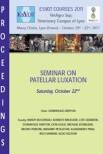Objectives: The aim of this study was to evaluate the effect of Kirschner wire insertion angle on the biomechanical characteristics following tibial tuberosity osteotomy fixation in dogs.
Study design: Twelve pairs of cadaveric tibia were harvested and randomly assigned to two treatment groups. Kirschner wires were placed either transversely (0 degrees) or placed caudodistally (30 degrees) with respect to the tibial tuberosity osteotomy. Each limb acted as its own respective control. Radiographic analysis allowed for the calculation of Kirschner wire insertion angle variance. Constructs were tested to monotonic failure while evaluating yield, peak, and failure forces, construct stiffness, and failure mode.
Results: Kirschner wire insertion angles were 1.1 ± 2.2 degrees and 30.5 ± 2.3 degrees, respectively, for 0-degree and 30-degree groups (p <0.0001). Yield (p = 0.0095), peak (p <0.024) and failure loads (p <0.030) were all significantly greater for Kirschner wires inserted at an angle of 0 degrees compared with 30 degrees. Construct stiffness did not differ regardless of insertion angle (p = 0.068). Failure mode did not differ (p = 0.87) with tibial tuberosity avulsion and Kirschner wire pull-out seen in the majority of constructs (67%).
Conclusion: Kirschner wires placed transversely (0 degrees) for tibial tuberosity osteotomy fixation were biomechanically superior, increasing yield, peak, and failure forces by 1.6 times, 1.3 times, and 1.4 times, respectively, to those placed in a caudodistal (30 degrees) orientation. Kirschner wire insertion angle is an important consideration following tibial tuberosity osteotomy in dogs, with Kirschner wires placed at 0 degrees conferring increased resistance of the repair to construct deformation.









